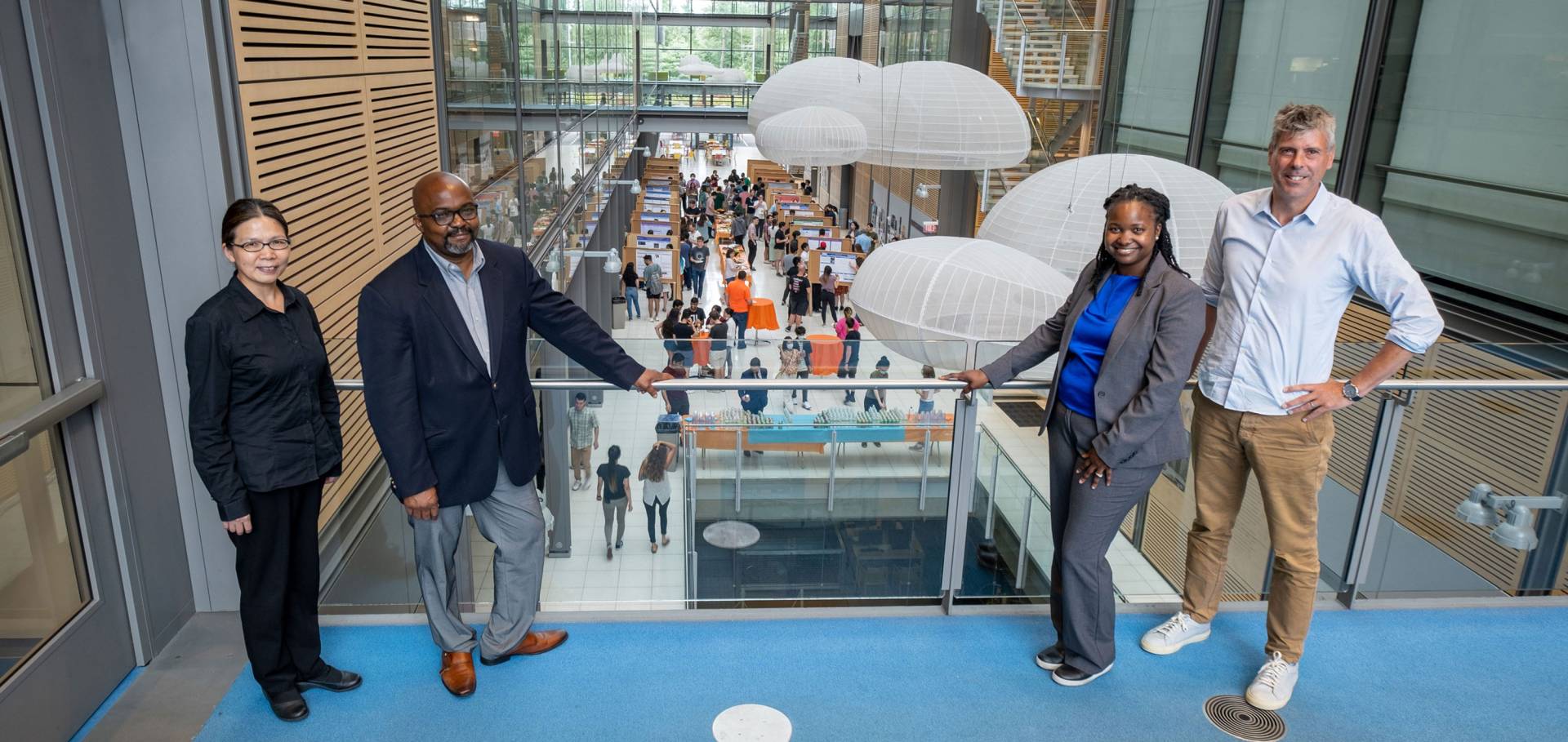How can we create a diverse network of colleagues? That deceptively simple question sparked an "unforgettable" initiative from the Department of Chemistry: the inaugural Visiting Faculty Research Partnership (VFRP), which wrapped recently with a symposium and poster session that celebrated visiting professors and their undergraduates from Fresno State, Rowan and Valdosta State universities.
The two-month summer program draws faculty from moderate to small research institutions that serve historically underrepresented groups. This inaugural year provided research and stipend funding to three visiting faculty who each brought two undergraduates with them.

Visiting faculty in Princeton Chemistry’s two-month Visiting Faculty Research Partnership, at Frick Laboratory. From left: Qiao-Hong Chen, professor in the Department of Chemistry and Biochemistry at California State University, Fresno; Tolulope Salami, professor in the Department of Chemistry at Valdosta State University; Rashanique Quarels, assistant professor in the Department of Chemistry and Biochemistry at Rowan University; and Princeton Chemistry Department Chair Gregory Scholes, the William S. Tod Professor of Chemistry.
The visitors paired up with Princeton faculty and embedded in labs, group meetings and workshops to complete research collaborations.
“I am thrilled to see the positive impact Princeton Chemistry’s VFRP had for all participating faculty and students,” said Shawn Maxam, associate provost for diversity and inclusion. “The relationships and collaborations developed seem to be exceptional. We know that talent exists everywhere, and our pursuit of academic excellence requires a robust engagement with diverse groups of scientists and scholars.
“My gratitude to the department for launching this program. I am excited by the future opportunities for science and collaboration catalyzed by VFRP,” he said.
The three visiting professors were Qiao-Hong Chen, professor in the Department of Chemistry and Biochemistry at California State University, Fresno; Rashanique Quarels, assistant professor in the Department of Chemistry and Biochemistry at Rowan University; and Tolulope Salami, professor in the Department of Chemistry at Valdosta State University.
VFRP is part of department chair Greg Scholes’ goal to open Princeton Chemistry to non-traditional routes of collaboration.
“What a great response we got for this program. It says a lot that we could make three top-quality appointments that spanned three different labs in our department,” said Scholes, the William S. Tod Professor of Chemistry. “We imagine that the experience will enhance the visiting students’ applications for graduate school or employment, and that we have seeded productive, long-term connections with them.”
Chen and her two students partnered with Erik Sorensen, the Arthur Allan Patchett Professor in Organic Chemistry, and his research group. After two months, Chen declared the program “an exciting, unforgettable summer of research. It’s been a great chance for me, for my two students who came with me, and my entire group at Fresno State. We were all so happy to do this.”
A first-generation college student herself, Chen chose two undergraduates to accompany her whom she felt would most benefit from the opportunity: Jasmine Hang and first-generation college student Khamyl Cooksey, both of whom traveled to the East Coast for the first time.
“Coming here pushed me a little bit more towards doing a Ph.D.,” said Hang. “I’m actually a biology major, so chemistry wasn’t ever anything I was going to touch other than the classes I need to take. But I really enjoyed the hands-on part of the lab. So now, I’m thinking maybe I can do research on campus.

Tolulope Salami (center) and his undergraduates Jayden Thomas (left) and Jodeci Mitchell (right) from Valdosta State University atttend the Summer Symposium Poster Session at Frick Laboratory.
“I have loved every moment of it,” she added. “Being able to work here and be a part of the whole environment where everyone is so research-driven, it just makes it so much more impactful.”
Said Cooksey: “The Sorensen Lab was very welcoming. We got to talk to the postdocs and graduate students and hear a lot about the paths they’ve taken. It’s definitely given me the opportunity to explore my options.”
Jodeci Mitchell, who visited with Salami from Valdosta, embedded with the Bocarsly Lab, the research group of Professor Andrew Bocarsly. “This program has given me access to more diverse experimentation and different equipment. Using that knowledge is definitely going to be useful to my career, no matter what I decide to do,” she said. “The hands-on activity in the lab is definitely beneficial in that aspect. Just getting used to the lab environment in general has been wonderful.”
Salami said he feels it’s important to continue learning throughout one’s professional career, and he found the opportunity to do that with the Bocarsly Lab.
“The students too, they’ve been encouraged that they can do this,” he said. “They had some trepidation about coming to Princeton, but when they got here, it was like, ‘Hmmm, I actually can do this. We’re all just chemists.’ I think it has done a lot to build their confidence.”
Quarels and her two students from Rowan University partnered with Rob Knowles, a professor of chemistry, and his research group. Quarles noted that the Knowles Lab has a piece of equipment integral to her research — a cryocooler, a refrigerator designed to reach cryogenic temperatures — that is not available at Rowan. “Just being able to utilize some of the resources here at Princeton was a big ‘check’ for me.”
She added that one of the students who accompanied her, Jonathan Santoro, was up until this point a chemical engineering major at Rowan. Following this summer’s fellowship, he plans to change his major to chemistry full time and continue on the path to graduate school.






